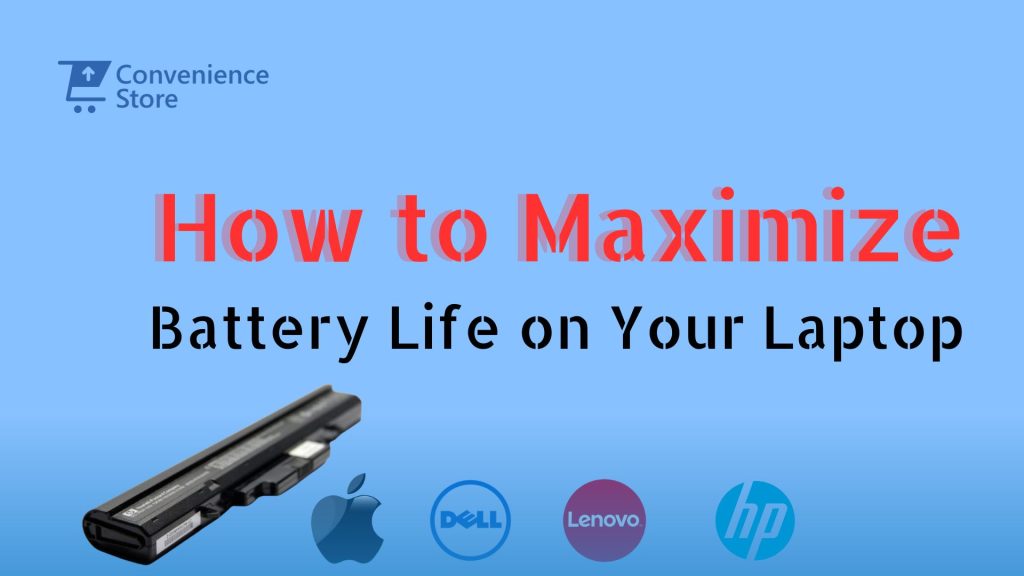A Comprehensive Guide: How to Maximize Battery Life on Your Laptop

The ever-increasing demands of the modern workplace necessitate reliable and long-lasting tools. Laptops, with their portability and versatility, have become the cornerstone of professional productivity. Yet, a persistent frustration for many users is the limitations imposed by battery life.
This comprehensive guide addresses this very challenge. We aim to empower you with actionable strategies to maximize your laptop’s battery performance. By understanding the core principles of battery technology and implementing practical adjustments to your software and hardware settings, you can ensure uninterrupted focus and seamless connectivity throughout your workday.
Understanding Laptop Battery Basics:
Before diving into specific tips, it’s essential to understand how laptop batteries work. Most modern laptops use lithium-ion (Li-ion) or lithium-polymer (Li-Po) batteries. These batteries are efficient but degrade over time due to various factors, including:
- Charge Cycles: Each full charge and discharge of the battery is considered a cycle. Over time, the battery’s capacity diminishes with each cycle.
- Temperature: Batteries perform best at moderate temperatures. Extreme heat or cold can negatively impact battery health.
- Usage Patterns: High-performance tasks like gaming, video editing, or running numerous applications simultaneously can drain the battery quickly.
Tips to Maximize Battery Life:
1. Adjust Power Settings:
One of the most effective ways to extend battery life is by tweaking your power settings. Most operating systems offer power-saving modes that can help conserve energy.
-
Windows:
- Power & Sleep Settings:
- Go to Settings.
- Navigate to System > Power & Sleep.
- Adjust the screen and sleep settings to shorter intervals.
- Shortening the time, it takes for your screen to turn off and your laptop to go into sleep mode when inactive can save significant battery power.
- Battery Saver Mode:
- Click on the battery icon in your taskbar.
- Select Battery Saver mode when the battery level is low.
- Battery Saver mode reduces the background activity and limits notifications, helping to extend battery life when power is running low.
- Power & Sleep Settings:
-
macOS:
- Energy Saver:
- Go to System Preferences.
- Select Energy Saver.
- Adjust the settings for Battery and Power Adapter.
- Tweaking these settings helps to ensure your laptop is running efficiently, reducing power consumption when on battery.
- Automatic Graphics Switching:
- Go to System Preferences.
- Select Energy Saver.
- Enable Automatic Graphics Switching.
- For MacBooks with dual graphics cards, this feature uses the integrated graphics for less intensive tasks, conserving battery life.
- Energy Saver:
-
Linux:
- TLP:
- Open your terminal.
- Install TLP using the package manager (
sudo apt install tlpfor Debian-based systems). - Start TLP with
sudo tlp start. - TLP is a power management tool specifically designed for Linux that optimizes battery usage by applying various system tweaks.
- Power Settings:
- Access power settings through the system settings menu.
- Adjust screen brightness, sleep, and suspend options.
- Configuring these settings ensures your laptop uses power more efficiently, extending battery life.
- TLP:
2. Manage Screen Brightness:
The laptop screen is a major power consumer. Reducing screen brightness can significantly impact battery life.
-
Manual Adjustment:
- Use your keyboard’s brightness keys to lower the brightness.
- Alternatively, go to your system settings and adjust brightness manually.
- Keeping your screen brightness at the lowest comfortable level can make a noticeable difference in battery longevity.
-
Adaptive Brightness:
- Windows:
- Go to Settings > System > Display.
- Enable Change brightness automatically when lighting changes.
- macOS:
- Go to System Preferences > Displays.
- Enable Automatically adjust brightness.
- Linux:
- Install the
brightnessctltool if not already available. - Use it to set up adaptive brightness settings.
- Install the
- Adaptive brightness automatically adjusts the screen brightness based on ambient light conditions, helping to conserve battery power without compromising usability.
- Windows:
3. Disable Unnecessary Hardware and Features:
Certain hardware components and features can drain the battery even when not in use.
-
Bluetooth:
- Windows: Go to Settings > Devices > Bluetooth & other devices and turn off Bluetooth.
- macOS: Go to System Preferences > Bluetooth and turn off Bluetooth.
- Linux: Use the Bluetooth manager tool to disable Bluetooth.
- Disabling Bluetooth when not in use prevents it from consuming power unnecessarily.
-
Wi-Fi:
- Windows: Click on the network icon in the taskbar and turn off Wi-Fi.
- macOS: Click on the Wi-Fi icon in the menu bar and turn off Wi-Fi.
- Linux: Use the network manager tool to disable Wi-Fi.
- Turning off Wi-Fi when you are not using it can save battery power, especially if you are connected to the internet via Ethernet or are offline.
-
External Devices:
- Safely eject USB drives, external hard drives, and other peripherals when not in use.
- Explanation: External devices draw power from your laptop, so unplugging them when they’re not needed helps to extend battery life.
-
Keyboard Backlight:
- Use your keyboard’s backlight control keys to reduce or turn off the backlight.
- While the backlight can be helpful in low-light conditions, turning it off when not needed can help conserve battery power.
4. Optimize Software Usage:
Software and applications running in the background can consume significant battery power.
-
Close Unnecessary Applications:
- Windows: Use Task Manager to close unnecessary applications.
- macOS: Use Activity Monitor to close unnecessary applications.
- Linux: Use the system monitor tool to close unnecessary applications.
- Keeping only essential applications open minimizes the load on your CPU and memory, which in turn reduces power consumption.
-
Background Processes:
- Windows: Use Task Manager to end unnecessary background processes.
- macOS: Use Activity Monitor to end unnecessary background processes.
- Linux: Use the system monitor tool to end unnecessary background processes.
- Background processes can drain battery life by using system resources, so closing them helps conserve energy.
-
Update Software:
- Ensure your operating system and all applications are up-to-date through the respective update managers.
- Software updates often include performance improvements and optimizations that can enhance battery efficiency.
5. Use Energy-Efficient Programs:
Some programs are more energy-efficient than others. Opt for software known to consume less power.
-
Browsers:
- Use energy-efficient browsers like Microsoft Edge or Safari for lower power consumption.
- Browsers like Edge and Safari are optimized to use less power, which can help extend battery life when browsing the web.
-
Media Players:
- Choose media players optimized for battery life, like VLC Media Player.
- VLC Media Player is known for its efficiency and can play media files without putting a significant strain on your battery.
6. Maintain Your Battery:
Proper maintenance can significantly extend the lifespan and performance of your laptop battery.
-
Regular Calibration:
- Fully charge your battery.
- Use your laptop until the battery is completely drained.
- Fully charge the battery again.
- Calibrating your battery helps the battery management system accurately measure its charge capacity, leading to better battery performance.
-
Avoid Complete Discharge:
- Try to recharge the battery before it drops below 20%.
- Frequently letting your battery drop to 0% can shorten its lifespan, so it’s best to recharge before it gets too low.
-
Don’t Overcharge:
- Unplug your laptop once it reaches 100% charge.
- Overcharging can lead to overheating and reduce battery health over time, so it’s advisable to unplug once fully charged.
-
Store Properly:
- If storing for a long period, ensure the battery is at around 50% charge.
- Storing your battery at a 50% charge level helps preserve its health during periods of inactivity.
7. Consider Battery Replacement:
If you’ve had your laptop for several years, the battery may have reached the end of its usable lifespan. Lithium-ion batteries typically last 2-4 years or 300-500 charge cycles before their capacity starts to degrade noticeably.
-
Signs of a Dying Battery:
- The battery drains faster than usual.
- The battery doesn’t hold a charge as long.
- The battery requires more frequent charging.
- These signs indicate that your battery is losing its capacity and efficiency, suggesting it might be time for a replacement.
-
Replacement:
- Check your laptop’s user manual or manufacturer’s website for battery replacement instructions.
- Purchase a compatible replacement battery.
- Follow the instructions to replace the battery or visit a professional service center.
- Replacing an old battery with a new one can restore your laptop’s battery life to its original capacity, providing longer usage times.
The key to maximizing laptop battery life is a multi-pronged approach. By understanding battery basics and how different factors impact it, you can make informed choices to extend its lifespan significantly.
The guide recommends various strategies: adjusting power settings, managing screen brightness, disabling unnecessary hardware, optimizing software usage, and proper battery maintenance. Additionally, consider using energy-efficient programs and replacing a degraded battery for optimal performance.
Following these tips and making small adjustments to your daily habits will ensure a longer-lasting battery, keeping your laptop a reliable tool for various needs.




